Include a Topper!
-
Happy Birthday Banner
$9.00 -
Turkey Cake Topper
$15.00
Add Ons
Your cart is currently empty!
Since 1949 celebrating 75 years. Order online or call us at 1 800 GAMBINO (426-2466)
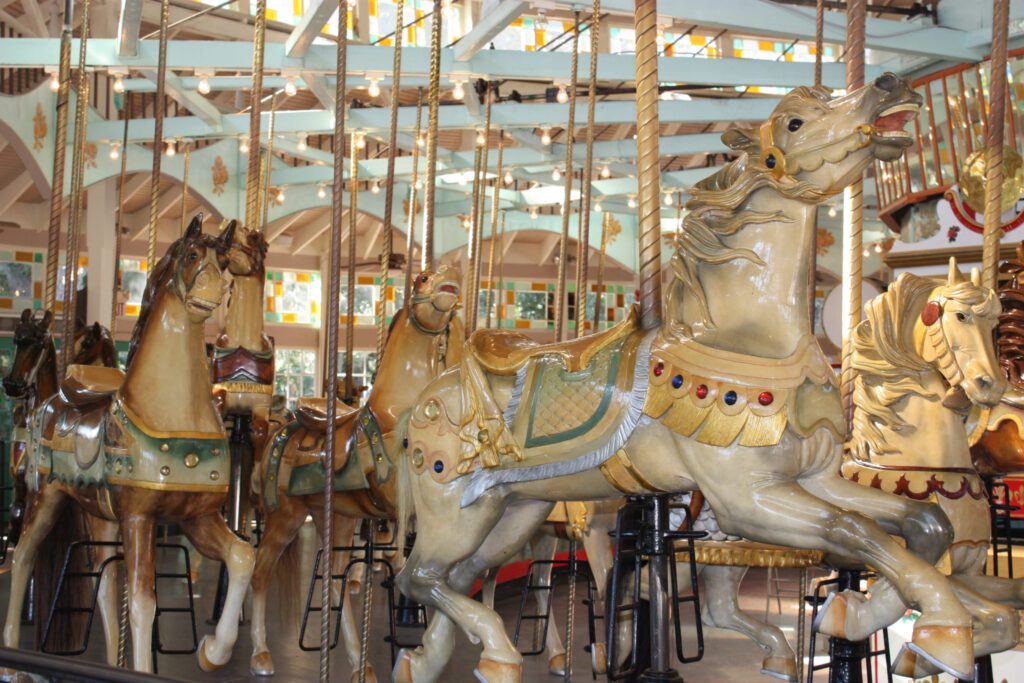
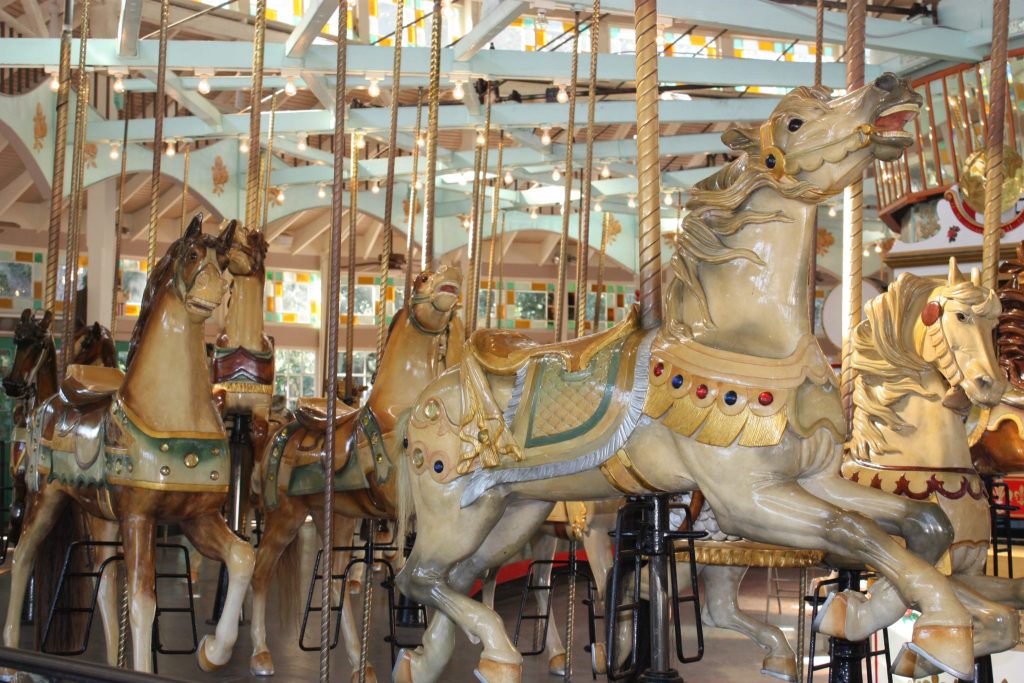
As the weather cools down, New Orleanians everywhere can finally return to outdoor activities! City Park is a favorite with more than 16 Million visits annually. The 20th most visited park in America has tons to do. A walk through the peaceful Couturie Forest. A kayak on beautiful Bayou Metairie. A round or two of mini-golf at City Putt. But it’s the carousel, at the park’s Carousel Gardens Amusement Park, that has been catching the imagination of New Orleans for approximately a century!
Known by many as the “Flying Horses,” the carousel brings joy to thousands of visitors each year. The attraction features 56 hand-carved wooden animals — 53 of which are horses, joined by Cammie the Camel, Leo the Lion, and Geoffrey the Giraffe — along with two chariots.
–
The figurines are flamboyant and each are uniquely designed, often bedecked with faux gemstones and tails made of real horse hair. The carousel has recently become a popular place for movie and television shoots — “Now You See Me”, “22 Jump Street” and “NCIS New Orleans” to name a few — and the animals are so beloved that they need to be repainted an average of every other year!
If you’re getting the feeling this isn’t just any carousel, then your intuition is right. The last of its kind in Louisiana, generations of New Orleanians think of it as one of the city’s great treasures.
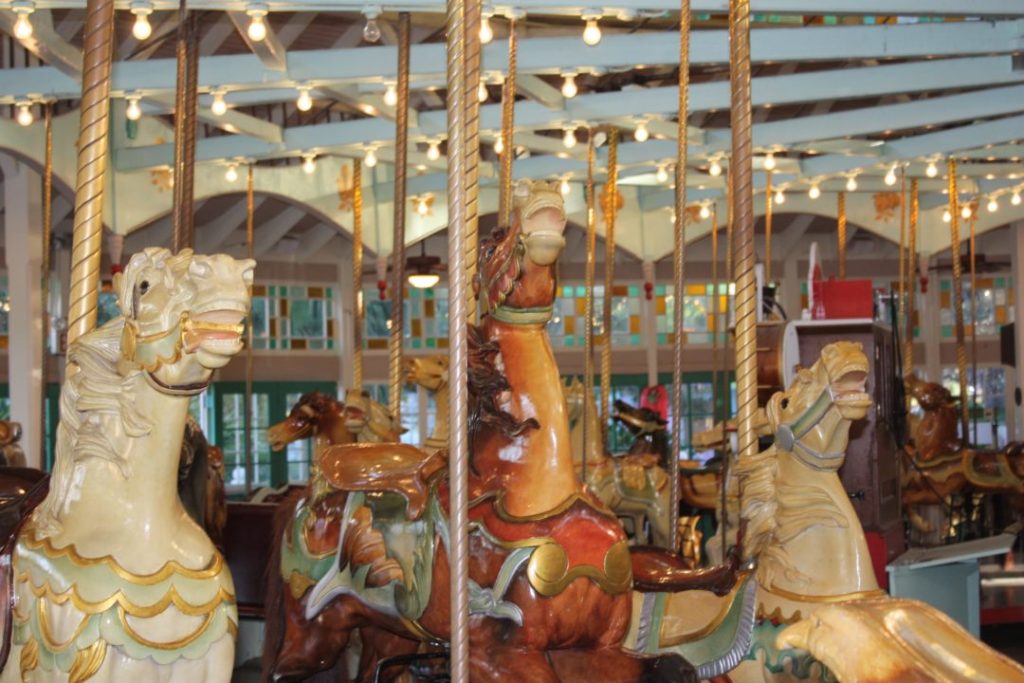
But why?
Let’s take a look back at some of this carousel’s unique, incredible history.
The word “carousel” comes from the Italian garosello and Spanish carosella, which both mean “little battle.” Though, you probably don’t look at those gem-studded Flying Horses — mouths agape, tongue dangling — and immediately think “battle.” So what’s the connection?
Well, carousels, aka “merry-go-rounds,” are thought to have had their beginnings in the training sessions of 12th century Turkish and Arabian warriors, during which horsemen would ride in a circle, tossing a clay ball filled with perfume to their fellow riders. The rider who failed to catch the ball would break it and reek of perfume for the rest of the day.
The training game made its way to Europe, but by the 17th century, the perfumed balls had been removed from the exercise in favor of small rings hanging from poles. The knight’s objective was to display their accuracy by spearing and tearing off the ring. Cavalry competitions like this replaced medieval traditions such as jousting, and were especially popular in Italy and France, which is where we first see the term carousel.
To prepare for the competition, the French created practice devices in which legless wooden horses were suspended from a central rotating pole, powered by human, horse or mule. It turns out the training sounded so fun that, during the 18th and 19th centuries, these early iterations of the carousel found their way to fairgrounds across Europe for public enjoyment.

They were hand-powered (using a hand-crank or pull rope), animal-powered, and even bicycle-powered, before — in 1861 — the first steam-powered merry-go-round was created in England. A local newspaper said the new contraption moved with such force it was a “wonder the daring riders are not shot off like cannon-balls, and driven half into the middle of next month.”
It was at this time, in the late 19th century, that European immigrants brought the carousel industry with them to the United States, ushering in the contraption’s golden age.
The American version was much larger than European carousels, and their woodwork was more elaborate. Before coming to America, the horses were almost-literally flying — whipped around by centrifugal force. Now, platforms were added for stability, and electric motors and lights gave carousels the classic, carnival look we recognize today.
As more Americans had disposable income for leisure, carousels grew in popularity across the country. Three styles — the Philadelphia style, the Country style, and the Coney Island style — competed for dominance.
Charles Looff was the first and most successful of the Coney Island style carousel builders. He was a German master carver and builder of amusement rides who immigrated to the United States in 1870. Six years later, he built legendary Coney Island’s first carousel.
In fact, he constructed more than 40 carousels in his lifetime, as well as numerous roller coasters, ferris wheels, and even Los Angeles’ famous Santa Monica Pier. Despite all of that, however, his fame remains tied to the unique Coney Island style of carousel carving, featuring flamboyant horses bedecked with faux-jewels and gold and silver leaf. The carousels, themselves, often feature mirrors to catch and reflect the light for added spectacle.
Looff trained many of the later artists closely associated with the Coney Island style, including Charles Carmel — whose horses are known for their “lolling tongues” — and Timothy Murphy.

It’s Timothy whose story we’re going to follow, because his notoriety didn’t end carving horses for Looff. He and his brother, Bartholomew, also built and operated carousels of their own, often mixing and matching horses from a variety of artists.
These business opportunities brought the Murphy brothers and their horses to amusement park locations across New York, Connecticut, Rhode Island, and even way down south to Louisiana.
The first carousel introduced to the people of New Orleans came in 1885. It was an installation at the World Cotton Centennial, which had begun a year earlier at what would soon become Audubon Park.
The aforementioned Bartholomew Murphy came to New Orleans at about this time and operated mule-powered rides in the Uptown park. His brother Timothy joined him in 1901 and they established the city’s first mechanically operated carousel at Audubon.
Five years later, Timothy returned to New York to join the firm, Nunnally-Murphy, one of the leading carousel makers in the country. Bartholomew stayed in New Orleans, moving his carousel operations to City Park and building an octagonal-framed building with a pyramidal roof in which to house the ride. (If this building sounds familiar to you, it’s because it still exists. But more on that later.)
A lot of people believe this is the carousel that still exists in City Park today, but after much review, that doesn’t appear to be the case. As mentioned earlier, the turn of the century was the golden age of carousels, so there were several merry-go-rounds operating at the same time in the city. And, because much of City Park’s records were lost during Hurricane Katrina, speaking definitively on where they all ended up is difficult.
But here’s what we feel confident saying:
The Old Spanish Fort Amusement Park was located along Bayou St. John, at the site of — as you might guess —the old Spanish fort, which was once located along Lake Pontchartrain. During its heyday, it was referred to as the “Coney Island of the South,” but the amusement park declined in popularity between 1890 and 1910.
About this time, in 1910, the Railways Company was attempting to operate a rival lakeside resort in the West End. This opened the door for the Old Spanish Fort Amusement Park to reclaim some of the market. They added a casino, a restaurant, a scenic railroad, a theater, a variety of ponds, and a carousel.
The carousel was ordered that year from Nunnally-Murphy, the firm Timothy Murphy returned to New York to join, and was delivered to the resort area at Spanish Fort. Those 54 animals — mostly horses, and many with tongues hanging out of their mouths and decorated in the Coney Island style with fake jewels — would be recognizable to any of us who have ridden the ride in the 109 years since.
The final part of this merry-go-round of merry-go-rounds isn’t possible without Harry J. Batt Sr., the New Orleans visionary who put smiles on the faces of generations of locals with his famous amusement parks.
In 1928, he opened Pontchartrain Beach, an amusement park on the lake end of Elysian Fields Avenue. He had ferris wheels, roller coasters, scramblers, “airplanes” and even a dolphin show!
But he didn’t have a carousel.
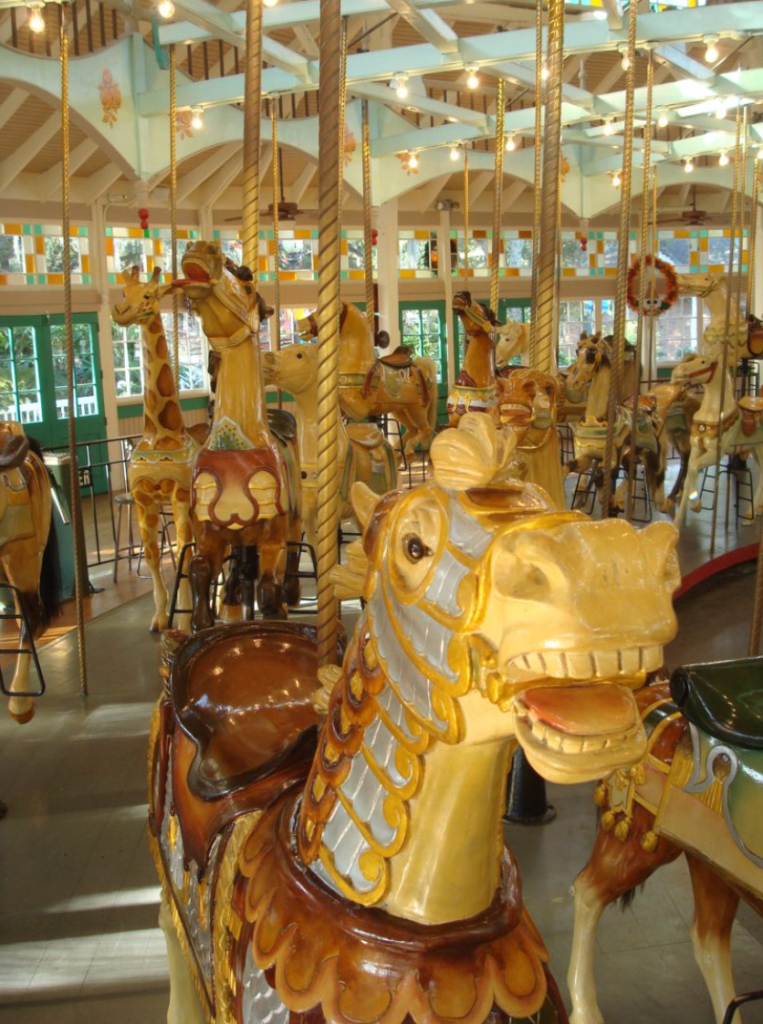
Remember that carousel that Bartholomew Murphy was operating in City Park? Well, in 1928, he sold it to Crescent Amusement Company who moved the flying horses, and the octagonal building it was in, to the back of the playground area where the building still resides to this day. Crescent Amusement reopened the slightly relocated park that year, calling it “Carousel Gardens.”
Crescent Amusement closed its operations during the Great Depression, selling the carousel to rival Henry D. Stock. And, in 1939, Batt finally saw his chance to get his carousel. He purchased it from Stock and moved it to his Pontchartrain Beach, where it remained until the resort closed in 1983.
But that meant there was no longer a carousel in City Park.
Don’t worry, Batt has us covered.
By 1938, the amusement park game was dominated by Pontchartrain Beach, and Old Spanish Fort was converted to a public park, much as it is today.
By now, we all know Batt loves a carousel. Doing business as Park Amusement, Inc., he purchased the Nunnally-Murphy merry-go-round from Old Spanish Fort and kept it in storage for a day he might need it.
That day came in 1948, when he took over the operation of Carousel Gardens’ rides. Because you know what they were missing?
Yup! He had that Nunnally-Murphy carousel from 1910 placed into that octagonal building from 1906, and they’ve been joined at the hip in Carousel Gardens ever since.
The only mystery left is who actually carved the animals. Nunnally-Murphy was known for hiring other artists to hand carve their figures. Amazingly, in “The Art of the Carousel,” author Charlotte Dinger asserts that at least two of the carvers were well known.
She writes that the horses, which show the characteristics of the Coney Island style, display the hallmarks of two of the school’s leading artists. Many of the horses on the outside row of the carousel show exaggerated hocks on their outside hind legs, relatively flat manes, plaster rosettes, tassels, and the occasional pug-nosed face. These are all characteristics of the Coney Island style’s previously mentioned founder, Charles Looff. Many of these horses are believed to have been carved as early as 1895!
And, on the inside two rows, many of the horses display the traits of Charles Carmel — who, you may recall, worked for Looff for several years — such as manes with a “reverse flow,” elaborate ornamentation, and tongues that hang out of the horse’s mouth.
When Pontchartrain Beach closed in 1893, that carousel was removed, leaving Carousel Gardens’ Nunnally-Murphy carousel as the last one in the city, one of only 100 or so hand carved carousels in the country, and the only hand carved carousel in Louisiana!
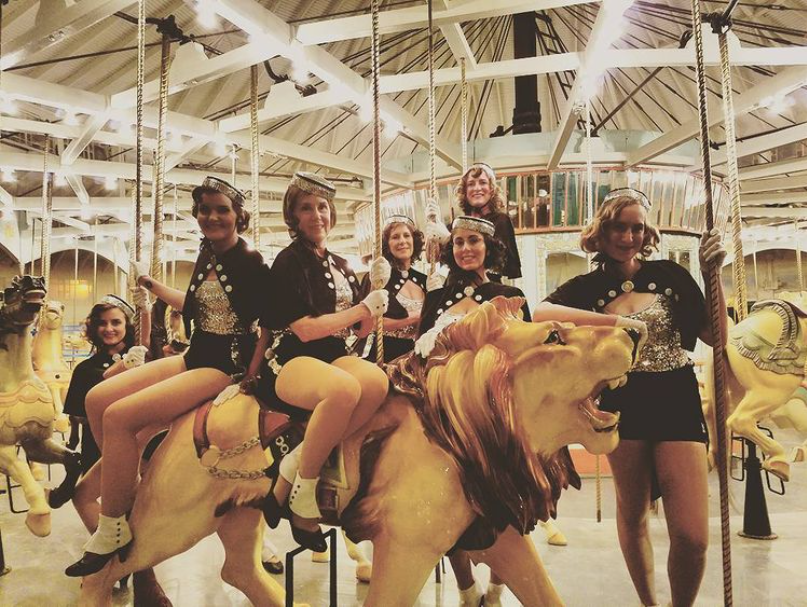
In the late 1980s, William B. Hines loaned Friends of City Park $300,000 to purchase the carousel from Batt (which to Batt’s credit, is less than he probably couldn’t have gotten if he didn’t want the carousel to stay in City Park), plus another $50,000 to repair the machine. Hines forgave the loan, which might be why Carousel Gardens is now called, The William B. Hines Carousel Gardens Amusement Park.
The carousel was placed on the National Register of Historic Places in 1988. One man, Bill Finkenstein of WRF Designs, has been maintaining the horses ever since, still hand-painting them as touch-ups are needed. He’s assisted by his son, Gabe.
The horses are hollow, which City Park employees say has given the carousel another, unintended, use. People hide photos, notes, and een money inside the horses. Like a time capsule.
Carousel Gardens hours vary, but are currently open from 11 a.m. until 6 p.m. on Saturdays and Sundays. The hours are extended during the summer, and you can also enjoy the carousel during the holiday season’s Celebration in the Oaks.
Visitors today will find two chariots and 56 animals, including the 500-pound Leo the Lion! The 53 horses are split into three categories: standers (three feet on the ground); jumpers (all four feet in the air); and prancers (two hind legs on the ground). And 30 of the horses are “flyers” — meaning they move up and down.